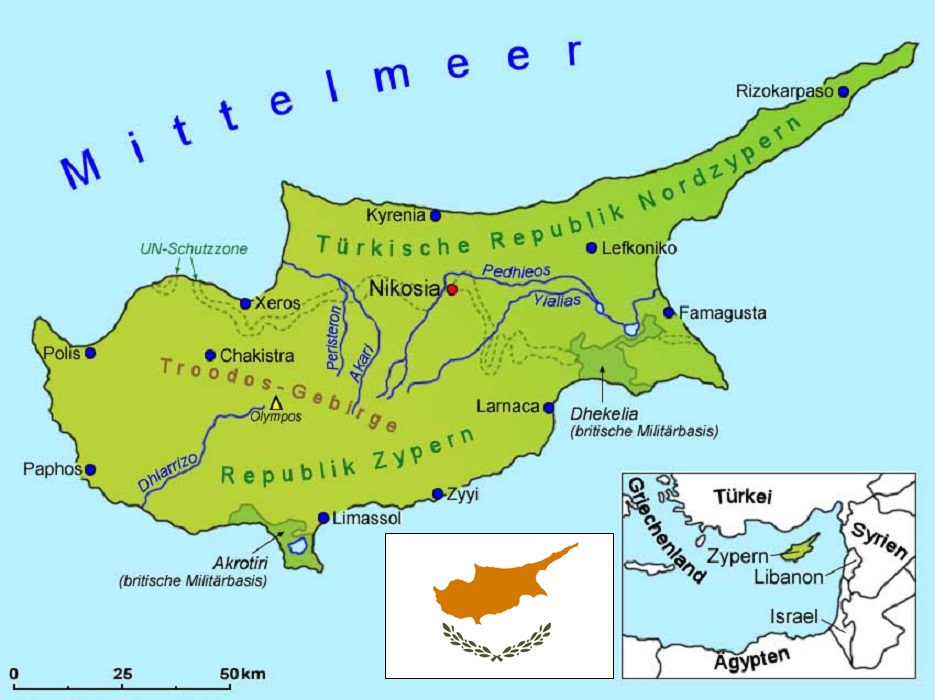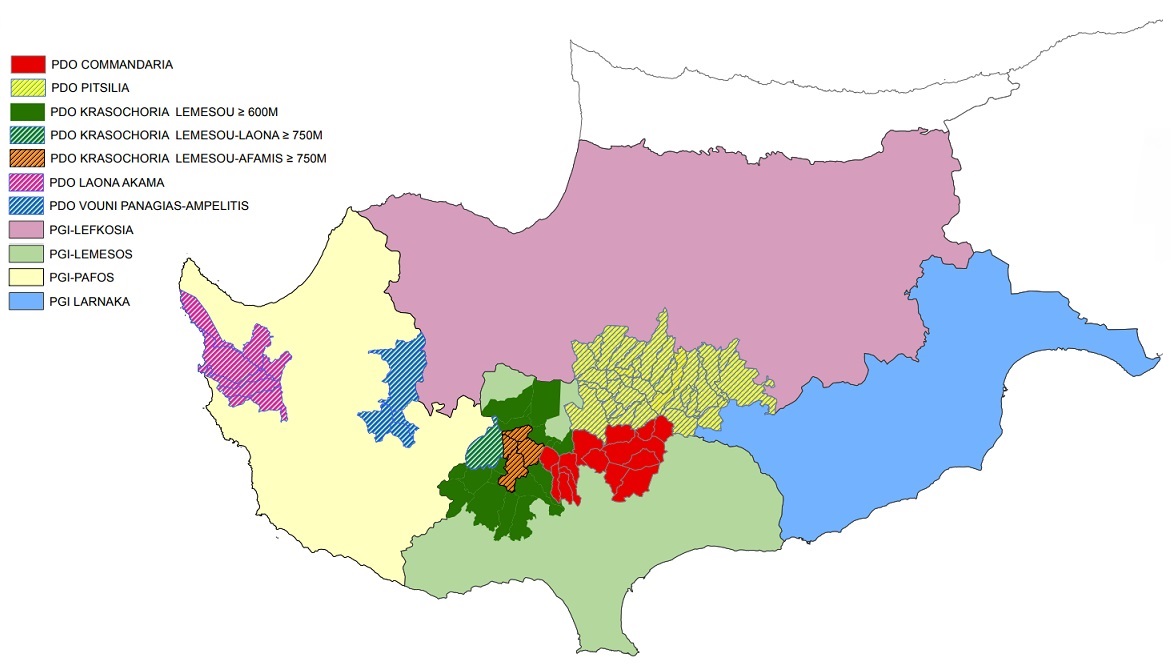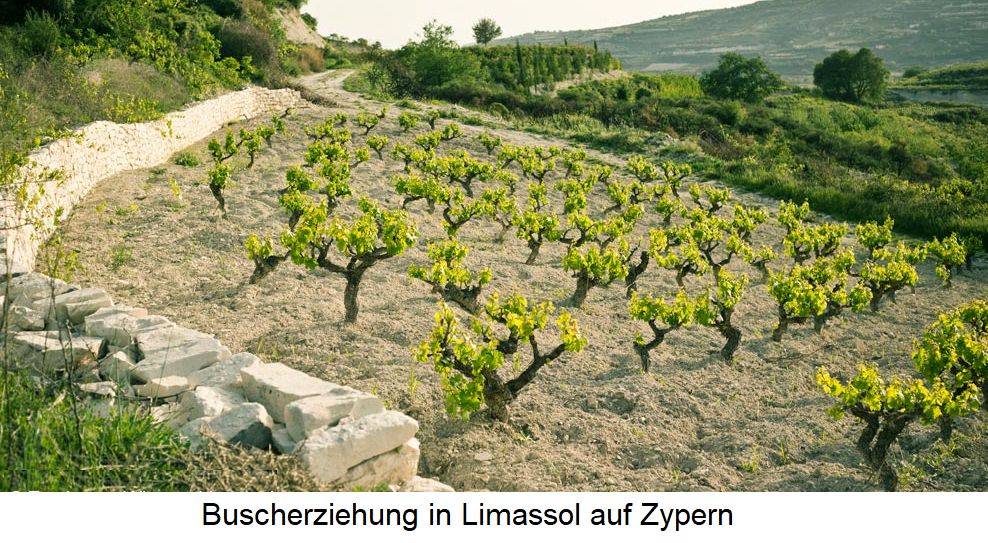Results
2,284 Results
Loading more Results ...
Loading more Results ...
Description to Cyprus
The island of Cyprus (Greek: Κύπρος Kypros, Turkish: Kıbrıs) in the eastern Mediterranean covers 9,251 square kilometres. It is only around 70 kilometres from the south coast of Turkey, just under 400 kilometres from the east coast of the Greek island of Rhodes and over 800 kilometres from mainland Greece. Although Cyprus belongs geographically to Asia, it is usually categorised politically and culturally as part of Europe. The island was under British rule from 1878 to 1960. It was not until 1925 that it was officially declared a British Crown Colony and thus also legally part of Great Britain (United Kingdom).

It became independent in 1960 and was absorbed into the Republic of Cyprus. Since 1974, a part of the island (3,355 km²) in the north of the Republic of Cyprus has been militarily occupied by the Turkish Republic in violation of international law. The Turkish Republic of Northern Cyprus propagated in this area is only recognised by Turkey. The description regarding viticulture refers to the unoccupied part of 5,384 km² with the capital Nicosia. It still includes the two British military bases Akrotiri and Dhekelia (255 km²). These are a remnant of the colonial era and are under British control.
History
Viticulture dates back to the 3rd millennium BC. According to mythology, the Greek god of wine Dionysus favoured wines from the island for his drinking parties. The foam-born Aphrodite emerged from the sea at the "Roman Rock" and came ashore on the Akamas peninsula. The Phoenicians and Greeks established the tradition of sweet wines in ancient times. This is evidenced by floor mosaics with wine motifs in the harbour town of Paphos on the south-west coast.
After the Third Crusade, the island came into the possession of the Order of St John in 1191, later the Order of the Knights Templar and from 1312, after their dissolution, the Order of St John again. The Order managed so-called Kommenden (estates with vineyards). Their headquarters was the still existing Kolossi Castle, known as the "Grand Commandery", which gave its name to the famous wine-growing region and the legendary sweet wine Commandaria. At that time, this coveted wine was supplied to many European ruling houses. From 1489 to 1571, Cyprus belonged to the Republic of Venice. Ottoman rule from 1571 to 1878 and the associated ban on alcohol caused a total decline in wine culture.
Viticulture in modern times
Under British rule from 1878 to 1960, there was a boom in viticulture. Commandaria and similar wines formerly known as "Cyprus sherry" developed into export favourites. From the early 1990s, Cypriot viticulture was reinvented, so to speak, by young, well-educated descendants of long-established families and a few investors. This new generation broke with the old myths and began to combine tradition and the Middle Eastern way of life with Western dynamism. A number of modern, well-equipped wineries were built in the villages of the Troodos Mountains. Zivania and ouzo are also traditional favourites on the island .

Wine-growing areas
The small vineyards in the barren scrubland form a perfect wine ecosystem that can largely do without artificial irrigation and chemical pesticides. Phylloxera has never reached the island, which is why the vines are planted ungrafted. It was not until the 1970s that European varieties were introduced to Cyprus. Most of the vineyards are located in the south-west of the island in the southern foothills of the Troodos Mountains at an altitude of 250 to 1,500 metres above sea level, making them some of the highest vineyards in Europe. Pitsilia and the northern half of Commandaria have volcanic soils, the other areas mainly limestone. The climate is typically Mediterranean, with mild winters, hot summers and low rainfall. It was only when Cyprus joined the EU in 2006 that an origin-orientated classification model based on the French model was introduced.
Quality wines (PDO)
Five areas are defined for origin-protected quality wines (OEOP = Oinos Eleghomenis Onomasias Proelefsis). These wines must come from vineyards located at an altitude of more than 600 metres above sea level. They must be made from 85% indigenous varieties such as Xynisteri (white), as well as Maratheftiko, Mavro or Ophthalmo (red). The proportion of Mavro may not exceed 60 or 70%, depending on the growing region. Vinification and bottling must take place in these areas:
Commandaria (Koumandaria, Κουμανδαρία)
The area comprises 14 municipalities in the southern foothills of the Troodos Mountains north of Limassol. It was the first to be defined in 1980.
Krasochoria Lemesou (Κρασοχώρια Λεμεσού)
The area comprises 20 municipalities in the southern foothills of the Troodos Mountains north of Limassol. Two sub-areas are Krasochoria Lemesou - Afames and Krasochoria Lemesou - Laona.
Laona Akama (Λαόνα Ακάμα)
The area comprises six municipalities on the coast in the north-west north of Paphos. The Akamas peninsula, which is steeped in myths, is a protected area due to its rich flora.
Pitsilia (Πιτσιλιά)
The largest area comprises 32 municipalities on the eastern edge of the Troodos Mountains above Commandaria and is also known for its fruit trees and rose cultures.
Vouni Panagias - Ampelitis (ΒουνίΠαναγιάς - Αμπελίτης)
The area is located in the central west of the island on the western edge of the Troodos Mountains north-east of Paphos.
Country wines (PGI)
The designation of origin for rural wines corresponds to the political subdivision with the four districts. Here, winegrowers are free to organise their own production, especially with regard to the use of international grape varieties. These are Larnaca (Λάρνακα), Lefkosia or Nicosia (Λευκωσία), Lemesos or Limassol (Λεμεσός) and Pafos or Paphos (Πάφος).

Grape variety index
In 2022, the vineyards covered 7,330 hectares of vines and the wine production volume was 108,000 hectolitres. Many are cultivated using the traditional bush training method (gobelet) shown in the picture above. Table grapes and sultanas are also produced. The grape variety game (Kym Anderson statistics):
| Grape variety | Colour | Synonyms or Cypriot name | Hectare |
| Mavro | red | Cypro Nero, Mavro Kyro, Staphili-Mavro | 3.187 |
| Xynisteri | white | - | 1.946 |
| Mazuelo | red | Carignan Noir | 481 |
| Sultana | white | Sultaniye | 371 |
| Cabernet Sauvignon | red | - | 369 |
| Syrah | red | Shiraz | 244 |
| Cabernet Franc | red | - | 203 |
| Monastrell | red | Mataro, Mourvèdre | 172 |
| Maratheftiko | red | - | 152 |
| Ofthalmo | red | - | 141 |
| Chardonnay | white | - | 128 |
| Muscat d'Alexandrie | white | - | 120 |
| Vertzami | red | Lefkada | 96 |
| Garnacha Tinta | red | Grenache Noir | 84 |
| Merlot | red | - | 63 |
| Spourtiko | white | Spourtico | 10 |
| Bastartiko | white | - | ? |
| Canella | white | Canella | ? |
| Flouriko | red | - | ? |
| Maroucho | red | - | ? |
| Michalias | white | - | ? |
| Morocanella | white | Morocanella | ? |
| Omoio | red | - | ? |
| Promara | white | Lycopromon | ? |
| Yiannoudi | red | Yiannoudhi | ? |
Producers
The majority of production is accounted for by the four large companies Etko, Keo, Loel and Sodap, based around Limassol in the south of the island. They mainly produce for export, primarily wine for industrial processing (e.g. sangria and Vermouth), grape must concentrate or RCGM (e.g. for British wine) and liqueur wines. These companies also own a number of regional wineries. The more than 50 private wineries only produce around 15% of the volume with increasingly high quality standards. These include Aes Ambelis, Amforeas (Kolios), Ampelokipeftiki, Antoniades, Ayia Mavri, Bolita, Chrisorogiatissa, Constantinou Distillery, Costas N. Erimoudes, Ezousa, Fikardos, Gaia, Hadjiantonas, Harma, Krelan, Kyperounta, Kykkos Monastery, Lagria, Linos, Menardos, Nelion, Nicolaides, Nikolettino, Vouni Panayias, Shoufas, Tsalapatis, Tsangarides, Tsiakkas, Vardalis, Vasa, Vasilikon, Vlassides, Yiaskouris, Zambartas, Zenon.
Map: © Goruma
PDO and PGI areas: Ministry of Agriculture
Vineyard area: Zambartas Winery - Limassol
Source 1st paragraph: WIKIPEDIA Cyprus
Classified wine producers in Cyprus 3
Recent wines 96
 Tsiakkas Winery
— Limassol
2020 PGI Lemesos Vamvakada / Βαμβακάδα
15.50 €
Tsiakkas Winery
— Limassol
2020 PGI Lemesos Vamvakada / Βαμβακάδα
15.50 €

 Vlassides Winery
— Limassol
2020 PGI Lemesos Dry "Óroman"
15.00 €
Vlassides Winery
— Limassol
2020 PGI Lemesos Dry "Óroman"
15.00 €


